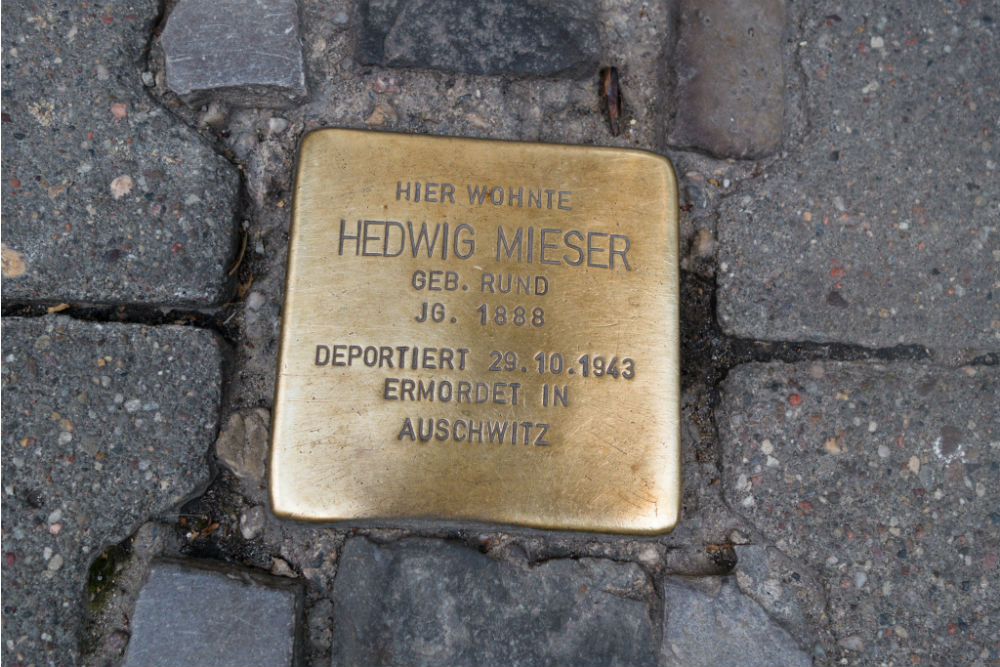Stumbling Stone Münzstraße 22
This small, brass memorial plaque (Stolperstein or stumbling stone) commemorates:
* Hedwig Mieser née Rund, born 1888, deported 29 October 1943, murdered in Auschwitz.
Hedwig Rund was a trained millener. In 1911, she married Ephraim Hirsch Hermann Mieser, a tailor. They had two children – Kurt Simon (born 1913) and Miriam (born 1920). The family lived in several locations in Berlin before coming to this house at Muenzstraße 22, which as of 2010 was still standing. They lived in an apartment on the third floor, where Hermann used one room for tailoring work. Besides running the household, Hedwig worked at various jobs: tailoring (helping her husband), typesetting, and, in the early 1930s, running a hat-making salon while her husband tailored clothing for Berlin companies. Then came the Nazi policies of restricting Jewish businesses.
Both children escaped. Kurt, age 21, went to Palestine in 1934. He tried without success to get an official invitation for his parents but was refused for lack of funds. In 1939, Miriam, age 19, went to Denmark as an agricultural assistant, then later went to Sweden and finally Palestine.
In Berlin, the Nazis forced Hermann Mieser to work as a tailor at Firma Michalski, at Große Frankfurter 137, where he was found dead in the workshop in November 1942. The official cause of death was cardiac vein calcification. After his death, Hedwig was able to hide from deportation for almost a year. But someone denounced her, and she and 49 others were deported from Berlin at the end of October 1943 to Auschwitz. None of the 50 is known to have survived the war.
"Stolpersteine" is an art project for Europe by Gunter Demnig to commemorate victims of National Socialism (Nazism). Stolpersteine (stumbling stones) are small, 10x10cm brass plaques placed in the pavement in front of the last voluntary residence of (mostly Jewish) victims who were murdered by the Nazis. Each plaque is engraved with the victim’s name, date of birth, and place (mostly a concentration camp) and date of death. By doing this, Gunter Demnig gives an individual memorial to each victim. One stone, one name, one person. He cites the Talmud: "A human being is forgotten only when his or her name is forgotten."
Do you have more information about this location? Inform us!
Source
- Text: Fedor de Vries & Anne Palmer
- Photos: Thom Quine
- Stolpersteine in Berlin: Hedwig Mieser
- Yad Vashem: Transport 45, Berlin-Auschwitz
- Stolpersteine.eu
Nearby
Museum
- Otto Weidt’s Workshop for the Blind - Berlin
- Anne Frank Centre - Berlin
- German Historical Museum (Zeughaus Berlin) - Berlin
Point of interest
- Bullet Impacts Große Hamburger Straße 28 - Berlin
- Former Gestapo Office Berlin - Berlin
- Rotes Rathaus - Berlin
Monument
- Memorial Franz Mett - Berlin-Mitte
- Memorial Jakob van Hoddis - Berlin
- Memorial Franz Mett - Berlin-Mitte
Cemetery
- Jewish Cemetery Schönhauser Allee - Berlin
- German War Graves Dorotheenstädtischer Friedhof - Berlin
- Mass Grave Germans Domfriedhof I - Berlin
Remembrance Stone
- Stumbling Stones Rochstraße 1 - Berlin-Mitte
- Stumbling Stone Max-Beer-Straße 6 - Berlin-Mitte
- Stumbling Stone Alte Schönhauser Straße 23-24 - Berlin-Mitte





